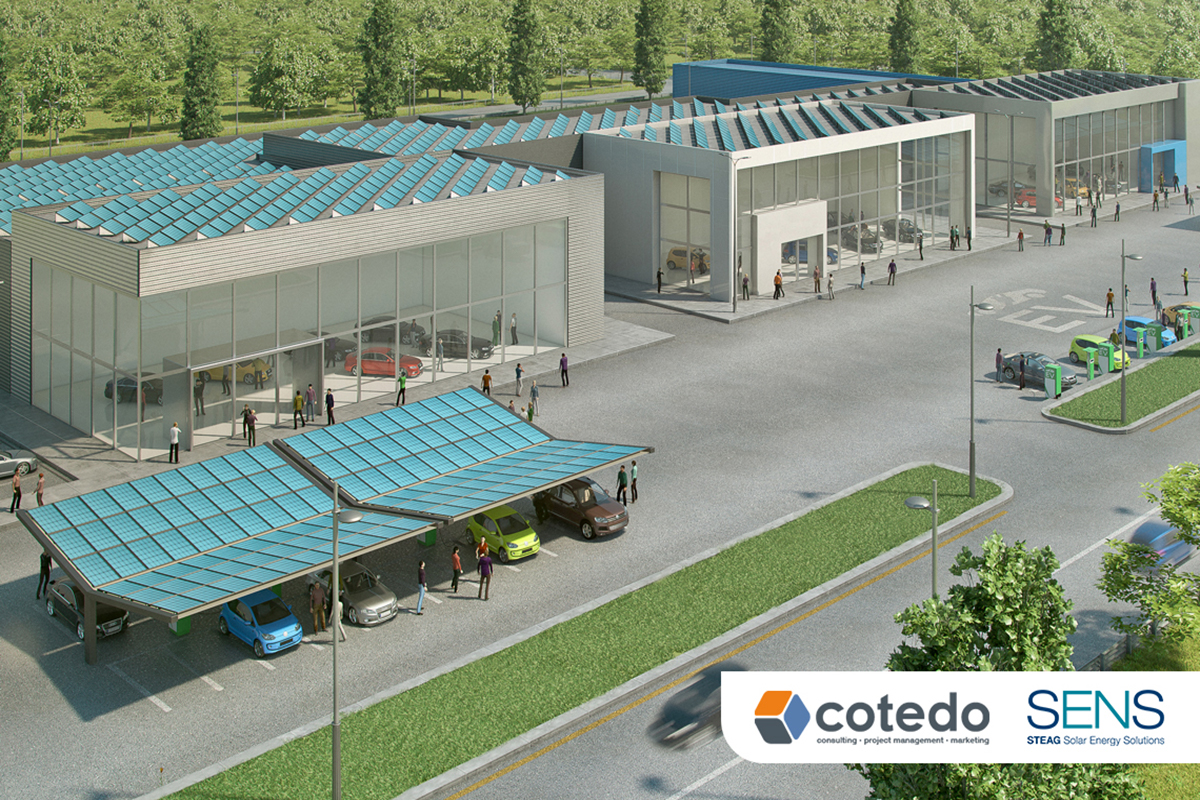
E-mobility: in future car dealers will refuel on sunshine
SENS offers e-mobility solutions for car dealerships
The demand for electric vehicles is growing steadily. What is lacking, however, is the nationwide infrastructure for charging them. Automobile manufacturers and car dealers are also increasingly responding to this requirement. What is needed are charging solutions for customers during repair and maintenance work, as well as for demonstration vehicles. The cooperation between SENS and the car dealership expert cotedo has now led to the joint development of customised solutions in the area of charging infrastructure and e-mobility for car dealerships.
"In more and more cases, the car dealerships are receiving precise specifications from the vehicle manufacturers. However, the installation of a single charging station is usually not enough," explains Moritz Wickert, Head of Energy Systems at STEAG Solar Energy Solutions (now: Global Director New Business & Innovation). "We support them with our complete solutions and modular systems consisting of e-charging stations, photovoltaic installations and energy storage batteries."
Flexible solutions based on an in-depth investigation of the location are required, because experience shows that the available power facilities are often unable to supply the planned charging stations. Since it can take some time for the energy suppliers to catch up with the relevant technology, car dealerships are turning to experienced experts. Thanks to the long-standing expertise of its cooperation partner cotedo in the automotive industry, SENS can offer car dealers individually tailored, all-round worry-free packages for their dealerships. These include not only the charging stations, but also the generation of green electricity by installing a photovoltaic system in combination with energy storage facilities.
Avoiding blackouts in future
As an initial step, an "E-Mobility Check" by the SENS subsidiary OPTENDA (until April 2020 GILDEMEISTER energy efficiency) from Stuttgart helps to determine the actual requirements and all the preconditions of the respective car dealership. This professional evaluation provides information on the annual and average load curve, as well as about demand peaks and power reserves at the grid connection point. Case studies by the subsidiary have already shown in the past that charging several electric vehicles simultaneously can have disastrous consequences at times when the power consumption of the car dealership is at its peak. If the maximum permissible power at the mains connection is exceeded the main fuse is tripped—and this can even happen with just two charging stations.
Such power failures can be remedied by continuous energy monitoring and careful and individual planning of the charging infrastructure, generating capacities and storage equipment where necessary. Using the data from the E-Mobility Check, as the next step SENS determines the concrete measures which are required, taking local conditions into account. At this point, questions about the number of charging points or the size of a PV installation on the roof of the car dealership are clarified. As soon as specifications on the number of charging stations are available, a concept for the feasibility of these stations is developed, taking into account further elements such as in-house generation and storage. Additional solar carports serve not only to protect the cars from environmental impacts (such as damage from hail), but also to generate electricity.
No-risk future investment
To ensure that customers get exactly what they need, the package is tailored precisely to their requirements. Especially during the planning phase, the experts from SENS attach particular importance to keeping the installation as modular as possible. As a result the photovoltaic system may be planned independently of the charging facilities. In the event of a possible technical overhaul of a charging station, this means that changes can be made without affecting the PV system. In addition, it is not unusual for retrofitting to become necessary due to changing requirements, and this should therefore be considered from the outset. For example, the installation may well need to be enlarged when demand increases, and with a modular design this can easily be implemented. And after successful installation our experts can if required also assume responsibility for the technical management of the facility.
